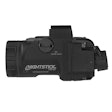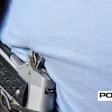One of the announcements that took me by surprise at last year's SHOT Show was that Para Ordnance, the Canadian firm best known for its line of high-capacity 1911s, was introducing a new AR-style rifle.
Not wanting to make just "another AR" Para gave its rifle a number of features that set it apart from the others. Most notable of these is its gas system, which Para says provides the shooter with the benefits of a piston-drive gun without the disadvantages.
Master Blaster
Not too long ago, I received a sample of the new Para USA Tactical Target Rifle. It features a 16-inch barrel, a side-folding Rapid Deployment Stock, and an innovative free floating handguard/rail system. It's designed to be used on the fields of competition or in combat.
Despite being a new offering from Para, this rifle, in a different guise, has been around for more than a decade. Allan Zitta, of ZM Weaponry, first designed what Para calls the Delayed Impingement Gas System (DIGS) in 1994.
Zitta needed a lightweight, accurate yet powerful handgun for the Masters competition. While most other competitors used a Remington XP-100, a bolt-action, single-shot pistol chambered for the .223 cartridge, Zitta redesigned the gas system of a standard AR rifle. He eliminated the buffer tube and spring and placed the action spring, wrapped around the op rod, above the shortened barrel. The ability to spend more time on target gave Zitta an edge in this timed event. In 1996 Zitta offered a commercial version of this handgun and called it the Master Blaster.
A couple years later Zitta received an invitation from the military to show them his prototypes. They asked if he could outfit the Master Blaster with a side-folding stock. The resulting gun was called the LR300. LR stands for Light Rifle and the 300 stands for the effective range of an 11.5-inch barrel with a 55-grain FMJ bullet. This gun, used and tested by spec ops, became the basis for Para's Tactical Target Rifle.
A Cleaner Machine
The heart of the DIGS gas system, licensed by Para from Zitta, is a very long, 10.5-inch gas key attached to the bolt carrier. It slides over a shortened gas tube near the gas block. Para calls this part the "op rod," and the action spring is wrapped around it, thereby eliminating the need for the buffer tube and spring. Because of this a side folding stock can be used, and this dramatically shortens the weapon's overall length when folded. The Tactical Target Rifle measures a compact 26.5 inches with the stock folded.
While the upper receiver looks like a standard flat top receiver, it is actually .200 inches taller to allow for the op rod to go through. The charging handle is also taller to accommodate these changes. Zitta made the feedramps lower to allow for different tolerance stacks between manufacturers of magazines.
Because the bolt carrier is shorter by 2.90 inches, the forward assist is also moved forward. A brass deflector has been built into the forward assist to keep brass out of the face of left-handed shooters.
Perhaps the biggest advantage of this system is that it keeps the gas residue out of the upper receiver. A cleaner gun equals better reliability and that equates to greater user confidence. The DIGS system also eliminates the "twang" that an AR user hears as the buffer and spring compress and then expand under his or her ear. Moving the action spring above the barrel also helps to push the rifle back down on target instead of up and into the shoulder. Para claims that the Tactical Target Rifle is the fastest production tactical gun built.
Pros Love It
Although I wasn't able to determine any difference in firing the Para Ordnance Tactical Target Rifle compared to other AR-15 style rifles there are some professional shooters who say they can.
Todd Jarrett, Para's top professional shooter, has been using a Zitta-built rifle for years—long before there was any sort of licensing agreement between Zitta and Para.
"For the past decade one of my top secret weapons in the competition world has been the Tactical Target Rifle," Jarrett says. "I have trusted it and used it exclusively for over 10 years. Its unique design lets me get on target faster with accuracy and reliability unmatched in any other rifle. And it is just fun to shoot."
Jarrett isn't the only professional shooter who has been using the Zitta-designed rifle. Rob Leatham and Michael Voigt, two of the world's best shooters, also use this weapon. The fact that these men, whose incomes are derived by their performance on the field of competition, selected this gun speaks volumes for the efficiency of the DIGS-equipped rifles.
Gas piston drive ARs have been all the rage as of late, and manufacturers are scrambling to get guns into production to satisfy customer demand. I asked Zitta about his design compared to piston driven systems. "They (piston guns) cost more to make, and you still need to clean the piston," Zitta says. "Piston driven guns keep more heat in the piston and the barrel because it doesn't allow for the bolt carrier to work as a heat sink. So with the piston guns, the barrel heats up more than a direct gas impingement system. I'm not trying to make digs against the piston system, but manufacturing costs, weight, and barrel heat are all factors that inspired me to go a different way."
[PAGEBREAK]
Adding Optics
Para equips the Tactical Target Rifle with a free floating aluminum handguard that possesses a rail at its forward end. This setup allows the user the choice of bare handing the handguard or attaching a vertical foregrip if desired. The top Picatinny rail is perfectly indexed to the receiver and allows for the forward mounting of optics should the user desire.
I mounted a Trijicon 3-9X 40 AccuPoint scope on the Tactical Target Rifle before testing it for accuracy at the range. I used a rifle rest for support and fired the five-shot groups from a cement bench. All groups were fired from a warm barrel without giving the barrel any time to cool.
Four of the six loads that I tried turned in sub-MOA accuracy (groups under an inch at 100 yards). This kind of precision is exactly what I like to see whether the gun is being used for tactical work or competition.
Insight Technologies sent me one of its new Integrated Sighting Modules (ISM-V) for evaluation. So I removed the Trijicon AccuPoint and installed the ISM-V on the receiver's Picatinny rail.
This sight provides the shooter with a red dot and a visible laser aiming point that are coaxially aligned. The combination should serve the user in just about any lighting scenario. You can use the red dot alone or with the laser.
The red dot is adjustable for brightness and features a relatively small, just 2 MOA, size dot that should work fine even for precision shots. What I like most about the ISM-V is its light weight—just 9 ounces with its single 3-volt Lithium battery installed. It boasts 1,500 hours of run time from the battery. Insight also offers a version called the ISM-IR, to qualified military and law enforcement agencies, which possesses an infrared illuminator and IR laser designator for use with night vision gear.
On a sunny August Arizona afternoon I set up some steel targets at a distance of about 30 yards. I had no problem finding the ISM-V's red dot, though it was nearly impossible to see the laser. I've used lasers before and this did not surprise me. They are most valuable in diminished lighting.
So I waited until just after sunset, when there was still a little ambient light and found that I could consistently hit my steel targets using just the laser at a distance of over 100 yards. The Insight ISM-V is as quick as any red dot or holographic sight and I feel that its ability to generate a laser, aligned with the red dot, makes it especially attractive to those searching for a tactical optic.
Para uses a standard 1:9 inches twist, which seems to have become the industry standard for its ability to accurately stabilize a greater number of bullet weights from 50 grains all the way to 75 grains.
Disassembly and Cleaning
For corrosion resistance and ease of cleaning, the barrel and chamber are chrome lined. It should also be noted that the op rod (or extended gas key) is plated with electroless nickel and the gas tube is chrome plated. In fact, Zitta tells people that this area of the rifle doesn't even need to be cleaned. "The wiping action of the stroke (the gas key slipping over the gas tube) and the gas pressure self-cleans this area and requires no lubrication."
To access the DIGS system, the user must first depress a spring-loaded plunger located at the muzzle end of the top rail and slide the rail forward and off the handguard. Next, pull back the action spring and remove the spring retaining clip and ease the spring forward. Push out the take down pin at the rear of the lower receiver, allowing the weapon to hinge open at the front take down pin, grasp the charging handle and remove it from the rear of the receiver and the bolt carrier and the op rod will come out with the charging handle. The bolt is disassembled in the same manner as any M-16 or AR-15 part. This is as far as you will need to disassemble the rifle for routine cleaning and maintenance.
I was amazed at just how clean the upper receiver of the Tactical Target Rifle was after I had fired about 450 rounds during my evaluation. Obviously, the DIGS system works as advertised. I used a rag to wipe down the op rod and gas tube and found surprisingly little firing residue.
Is the new Para Tactical Target Rifle, with its DIGS gas system, the next evolutionary step in the ongoing development of the AR-15/M-16 family of weapons?
It's hard to say at this point. One thing is certain, if shooters think that this particular design will give them some sort of edge, the DIGS will develop a huge following.
These new Para rifles, in fact all Para guns, will be built at a new manufacturing facility in North Carolina.
Want FREEInfo? Visit Para USA Online
Mike Detty is an NRA-certified rifle, pistol, and shotgun instructor. A certified rangemaster and competition shooter, Detty served as an officer in the U.S. Marine Corps and holds a degree in criminal justice from the University of Arizona.

















